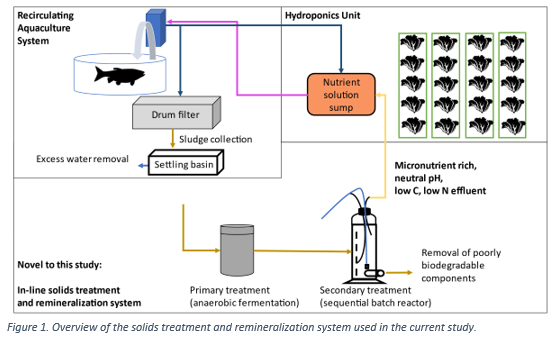MAXIMIZING THE GREEN POTENTIAL OF AQUAPONICS THROUGH NUTRIENT MANAGEMENT
The rapid expansion of the aquaculture industry has brought about a heightened focus on the waste produced by high-intensity fish farming. In closed containment recirculating aquaculture systems (RAS), fish solids are mechanically separated and/or coagulated before being disposed as waste, with no subsequent revalorization. Recent developments to improve the reuse of RAS waste streams, for instance to fertilize downstream hydroponically grown plants (aquaponics), present an opportunity for innovation in waste treatment. In this research, we developed a novel, in-line, low-cost solid waste treatment system for freshwater RAS adapted from an enhanced biological phosphorus removal (EBPR) process. After an initial laboratory test using freshwater RAS solids, the system was operated in an aquaponics facility over a 3-month period, producing 450 kg of rainbow trout (Oncorhynchus mykiss) and 39 kg of lettuce (Lactuca sativa). Total suspended solids were reduced by 59.21% ±39.68 overall, stabilizing to 87.27% ± 9.95 over the duration of the greenhouse integration into the RAS loop. The removal of solids-bound nitrogen from the system averaged 39.91% ± 15.95 over the entire duration of the experiment (figure 1). Little residual biomass was produced (4.04 g ± 2.67 weekly) and the effluent pH was neutral (7-7.5). In addition to carbon and nitrogen removal, the system increased the solubility of trace nutrients creating a liquid fertilizer effluent highly suitable for aquaponics cultivation both in terms of concentration and bioavailability of nutrients. The present solids treatment system represents an improvement over existing solids removal methods which hitherto have been restricted to relatively costly strategies such as filtration followed by physical collection, or conversion to biomass that requires significant downstream processing. This study contributes to the expanding body of research on nutrient extraction from fish solids. By contextualizing this process as a means to deliver nutrients to a downstream greenhouse, we propose its use in aquaponics as a cost-effective remineralization strategy.
